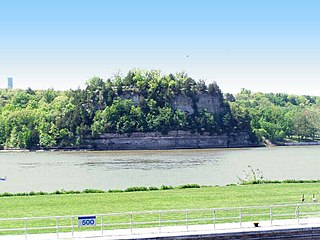
Starved Rock State Park is a state park in the U.S. state of Illinois, characterized by the many canyons within its 2,630 acres (1,064 ha). Located just southeast of the village of Utica, in Deer Park Township, LaSalle County, Illinois, along the south bank of the Illinois River, the park hosts over two million visitors annually, the most for any Illinois state park.

Fort de Chartres was a French fortification first built in 1720 on the east bank of the Mississippi River in present-day Illinois. It was used as the administrative center for the province, which was part of New France. Due generally to river flooding, the fort was rebuilt twice, the last time in limestone in the 1750s in the era of French colonial control over Louisiana and the Illinois Country.
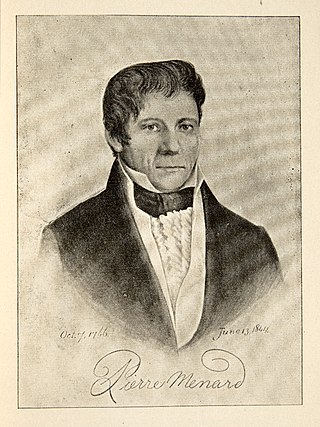
Pierre Menard was a Canadian-American fur trader and politician who was elected the first lieutenant Governor of Illinois in 1818.
The Illinois Historic Preservation Division, formerly Illinois Historic Preservation Agency, is a governmental agency of the U.S. state of Illinois, and is a division of the Illinois Department of Natural Resources. It is tasked with the duty of maintaining State-owned historic sites, and maximizing their educational and recreational value to visitors or on-line users. In addition, it manages the process for applications within the state for additions to the National Register of Historic Places and other federal preservation schemes.
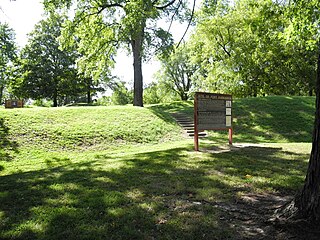
Fort Kaskaskia State Historic Site is a 200-acre (0.8 km2) park near Chester, Illinois, on a blufftop overlooking the Mississippi River. It commemorates the vanished frontier town of Old Kaskaskia and the support it gave to George Rogers Clark in the American Revolution.

The John Deere House and Shop is located in the unincorporated village of Grand Detour, Illinois, near the Lee County city of Dixon. The site is known as the location where the first steel plow was invented by John Deere in 1837. The site includes Deere's house, a replica of his original blacksmith shop, a gift shop, and an archaeological exhibit showing the excavation site of his original blacksmith shop. The Deere House and Shop is listed on the National Register of Historic Places; it joined that list in 1966, the year the Register was established. Prior to that, it was designated a National Historic Landmark on July 19, 1964.

The Magnolia Mound Plantation House is a French Creole house constructed in 1791 near the Mississippi River in Baton Rouge, Louisiana. Many period documents refer to the plantation as Mount Magnolia. The house and several original outbuildings on the grounds of Magnolia Mound Plantation are examples of the vernacular architectural influences of early settlers from France and the West Indies. The complex is owned by the city of Baton Rouge and maintained by its Recreation Commission (BREC). It is located approximately one mile south of downtown.

Melrose Plantation, also known as Yucca Plantation, is a National Historic Landmark located in the unincorporated community of Melrose in Natchitoches Parish in north central Louisiana. This is one of the largest plantations in the United States built by and for free people of color. The land was granted to Louis Metoyer, who had the "Big House" built beginning about 1832. He was a son of Marie Thérèse Coincoin, a former slave who became a wealthy businesswoman in the area, and Claude Thomas Pierre Métoyer. The house was completed in 1833 after Louis' death by his son Jean Baptiste Louis Metoyer. The Metoyers were free people of color for four generations before the American Civil War. The Métoyer family was derived from Marie (a former slave and Claude, a Spanish military gentleman who bought and married Marie. They had many children but they were also one of the largest plantations and owned slaves themselves.

The Ste. Genevieve National Historical Park, established in 2020, consists of part or the whole of the area of the Ste. Genevieve Historic District, which is a historic district encompassing much of the built environment of Ste. Genevieve, Missouri, United States. The city was in the late 18th century the capital of Spanish Louisiana, and, at its original location a few miles south, capital of French Louisiana as well. A large area of the city, including fields along the Mississippi River, is a National Historic Landmark District designated in 1960, for its historically French architecture and land-use patterns, while a smaller area, encompassing the parts of the city historically important between about 1790 and 1950, was named separately to the National Register of Historic Places in 2002.

The Felix Vallé House State Historic Site is a state-owned historic preserve comprising the Felix Vallé House and other early 19th-century buildings in Ste. Genevieve, Missouri. It is managed by the Missouri Department of Natural Resources.

Kent Plantation House is the oldest standing structure in Central Louisiana. Listed since 1971 in the National Register of Historic Places, Kent House is located in Alexandria in Rapides Parish. The plantation house is a representation of southern plantation life between 1795 and 1855. The main structure was erected in 1800 with the labor of people enslaved by Pierre Baillio. The bousillage Creole house and restored period outbuildings are now a showcase for tourists.

Longfellow-Evangeline State Historic Site, located in St. Martinville, Louisiana, showcases the cultural significance of the Bayou Teche region. It is the oldest state park site in Louisiana, founded in 1934 as the Longfellow-Evangeline State Commemorative Area. Evangeline was Henry Wadsworth Longfellow's enormously popular 1847 epic poem about Acadian lovers, who are now figures in local history. In the town center, the Evangeline Oak is the legendary meeting place of the two lovers, Evangeline and Gabriel. A statue of Evangeline marks her supposed grave next to St. Martin of Tours Church. The state historic site commemorates the broader historical setting of the poem in the Acadian and Creole culture of this region of Louisiana.

The Creole House is a historic residence in the village of Prairie du Rocher, an old French settlement in present-day Randolph County, Illinois, United States. Built at the end of the eighteenth century and later expanded, the Creole House is the last survivor in Illinois of its type of vernacular architecture, and it forms an important part of the built environment of a portion of the Upper Mississippi Valley that possesses an unparalleled connection to the French settlement period.

The Gene Stratton-Porter Cabin, known as the Cabin at Wildflower Woods and the Gene Stratton-Porter State Historic Site, is the former home of Gene Stratton-Porter, a noted Indiana author, naturalist, and nature photographer. The two-story, fourteen-room cabin, which was built in 1914, is located at Sylvan Lake near Rome City in Noble County, Indiana. Stratton-Porter lived full-time in the cabin from 1914 through 1919, then relocated to homes in California, where she continued to write and founded a movie studio. She returned to Wildflower Woods in Rome City for brief visits until her death in 1924. The property was listed on the National Register of Historic Places in 1974.
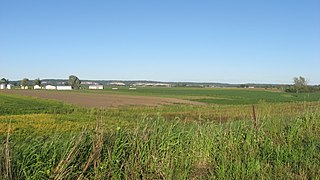
The Kolmer Site is an archaeological site in the far southwest of the U.S. state of Illinois. Located near Kaskaskia and Prairie du Rocher in western Randolph County, it lies at the site of an early historic Indian village from the French period. Because it occupies a critical chronological and cultural position, it has been given national recognition as a historic site.
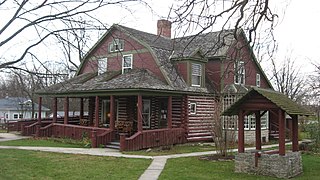
Gene Stratton-Porter Cabin, , known as the Limberlost Cabin and the Limberlost State Historic Site, was the former home of Gene Stratton Porter, a noted Indiana author who lived in the home from 1895 to 1913. The two-story, fourteen-room log cabin is located near the Limberlost Swamp on the outskirts of Geneva in Adams County, Indiana. Stratton-Porter designed the Queen Anne-style rustic home with the help of an architect. It was listed on the National Register of Historic Places in 1974.
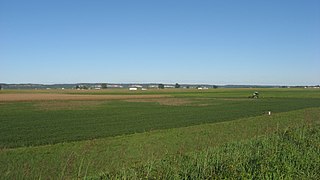
The French Colonial Historic District is a historic district that encompasses a major region of 18th-century French colonization in southwestern Illinois. The district is anchored by Fort de Chartres and Fort Kaskaskia, two important French settlements and military posts in what was then the Illinois Country. The Kaskaskia village site is also included within the district; it includes the Pierre Menard House, the only surviving building from Illinois' first state capital. Over a dozen French houses in Prairie du Rocher are also part of the district, including the poteaux-sur-sol Creole House and the 1735 Meilliere House. In addition to the French sites, the district also includes several Native American archaeological sites, such as the Modoc Rock Shelter, the Kolmer Site, the Waterman Site, and the Henke Site.

The Kaskaskia–Cahokia Trail was the first road in Illinois, running from Kaskaskia to Cahokia.






















